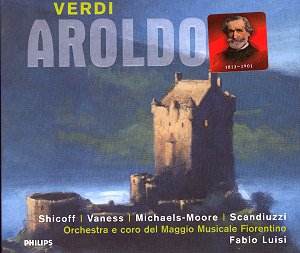Verdi’s opera Aroldo (1857) was a reworking
of Stiffelio (1850) forced on him by censorship. Though very
formulaic in its structures, choruses, arias and ensembles, the usual
climactic finale to Act Two, rousing cabalettas, offstage choruses with
accompanying organ, and a libretto peppered with the familiar operatic
cries of ‘Gran Dio’, ‘Orrore’, ‘Cielo’, and ‘Che di?’, there is glorious
music here, starting with an extraordinary Overture worthy of the concert
hall. It has an extended trumpet solo at the beginning (creamily played
here) followed by rousing playing by the Orchestra of the Maggio Musicale
Fiorentino under Fabio Luisi, who clearly believes in this opera (he
also does Alzira
464 628 and Jérusalem
426 613 in the series which is largely dominated by transfers from
vinyl of Lamberto Gardelli’s pioneering work in the 1960s). The music
is best in the third act with Egberto’s aria ‘Mina, pensai che un angelo’
given an impassioned performance by the increasingly impressive British
baritone Anthony Michaels-Moore. Carol Vaness in the act’s final aria
‘Non allo sposo’ with its plaintive cor anglais backup is proving herself
to be a Verdian of the highest dramatic colour, it’s years since her
stormy Donna Anna at Glyndebourne (in Mozart’s Don Giovanni that
is). Neil Shicoff in the title role has intermittent strain with a tightening
sound here and there, the voice now considerably heavier than his Duke
in Rigoletto. A slightly wobbly Roberto Scandiuzzi sings the
Hermit, which seems to be another inevitable prerequisite for Verdi’s
operas of this period (such as I Lombardi).
Having mentioned the orchestration of the overture,
there are also novel sounds later on, such as the opening of the last
(fourth) act with its hunting horns (apart from moments in Otello,
Verdi is not an attraction to an orchestra’s horn section) and rustic
pseudo-Scottish wind bands. What did he think they got up to north of
the border when it came to playing instruments? Still it’s a rousing
chorus full of typical Verdi rhythms, once again the well-tried and
tested formulas proving their worth right up to the final diminuendo
as they all go dancing off over heather-strewn glens! Then follows a
long unaccompanied Ave Maria for chorus and soloists introduced by a
village bell, which in rehearsals was out of tune, so Verdi worked on
it with a file until he obtained the right note. No such problems here,
the tuning of all, bell and singers, is spot on. The ensuing storm (excellently
played and sung) is colourful, vivid, full of flashing lightning and
shrieking piccolos, rumbling thunder, trumpets and trombones having
a field day - a cross between the traditional effects Beethoven used
in his Pastoral symphony and what Verdi was to produce 30 years
later in the aforementioned Otello.
The first three acts take place in Kent (Aroldo is
a Saxon knight who has been fighting crusades in Palestine) before it
all moves north, and the year is 1200. With a character called Brian
in the castlist it all hovers dangerously on the fringes of Monty Python
but, thanks to fine singing and playing, manages to hold its own as
an attractive prospect. There’s no way the frontispiece photograph of
Verdi in the CD booklet was taken in 1859, more like 1899. Come on proof-readers
- do your job properly!
Christopher Fifield

![]() Orchestra and Chorus of
the Maggio Musicale Fiorentino
Orchestra and Chorus of
the Maggio Musicale Fiorentino ![]() PHILIPS 462 512- 2 [126.41]
PHILIPS 462 512- 2 [126.41]